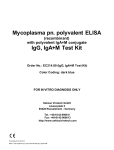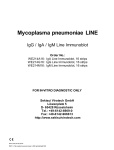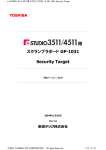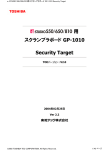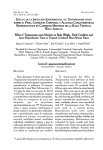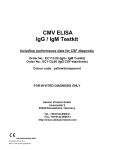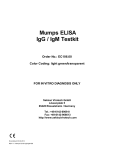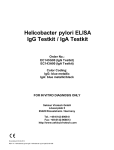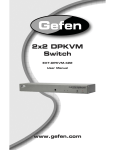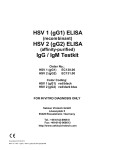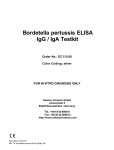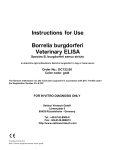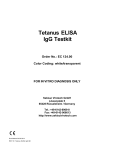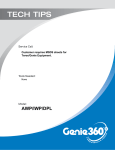Download Package Insert - Sekisui Diagnostics
Transcript
Mycoplasma pneumoniae ELISA (recombinant) IgG / IgM Testkit IgA-Set Order No.: EC114.00 (IgG/IgM Testkit) Order No.: EC114.08 (IgA-Set) Color Coding: dark blue FOR IN VITRO DIAGNOSIS ONLY Sekisui Virotech GmbH Löwenplatz 5 65428 Rüsselsheim - Germany Tel.: +49-6142-6909-0 Fax: +49-6142-966613 http://www.sekisuivirotech.com Druckdatum 04.02.2014 REV 23 / My coplasma pneumoniae ELISA IgG/IgM/IgA GB Contents 1. Intended Use ......................................................................................................................... 3 2. Diagnostic Relevance ............................................................................................................ 3 3. Test Principle......................................................................................................................... 3 4. Package Contents ................................................................................................................. 3 4.1 4.2 IgG/IgM Testkit ................................................................................................................................................................ 3 IgA-Set ............................................................................................................................................................................ 4 5. Storage and Shelflife of the testkit and the ready to use reagents ........................................ 4 6. Precautions and Warnings .................................................................................................... 4 7. Material required but not supplied......................................................................................... 4 8. Test Procedure ...................................................................................................................... 5 8.1 8.2 8.3 8.4 9. Examination Material....................................................................................................................................................... 5 Preparation of Reagents ................................................................................................................................................. 5 Virotech ELISA Test Procedure....................................................................................................................................... 5 Usage of ELISA processors ............................................................................................................................................ 6 Test Evaluation ...................................................................................................................... 6 9.1 9.2 9.3 9.4 9.5 Test function control........................................................................................................................................................ 6 Calculation of the Vir otech Units (VE) ............................................................................................................................. 6 Interpretation of Results .................................................................................................................................................. 6 Interpretation Scheme ..................................................................................................................................................... 7 Limits of the Test............................................................................................................................................................. 7 10. Performance Data .................................................................................................................. 7 10.1 10.2 10.3 10.4 10.5 10.6 Analytic al Sensitivity and Specif icity ................................................................................................................................ 7 Diagnostic Sensitivity ...................................................................................................................................................... 8 Diagnostic Specif icity ...................................................................................................................................................... 8 Prevalence (Expected Values) ........................................................................................................................................ 8 Intra-Assay Coefficient of Variation (Repeatability) ......................................................................................................... 9 Inter-Assay Coefficient of Variation (Reproducibility)....................................................................................................... 9 11. Literature ............................................................................................................................... 9 12. Test Procedure Schemata ................................................................................................... 10 Seite 2 v on 10 My coplasma pneumoniae ELISA IgG/IgM/IgA GB REV 23 Druckdatum 04.02.2014 1. Intended Use The Mycoplasma pneumoniae ELISA is used for the semiquantitative and qualitative detection of IgG, IgM and IgA antibodies in human serum. The detection of IgG antibodies is set so that it mainly detects fresh infections. 2. Diagnostic Relevance The bacteria Mycoplasma pneumoniae, w hich is lacking cell w all components, is the cause of atypical pneumonia and tracheobronchitis of humans and affects mostly children, young adults and immunodeficient people (1,2,3,4). So called adhesins (6), enable the bacteria to attach to the epithelial cells, against w hich the host develops antibodies. Studies made by Foy show , that in the USA 15 to 20% of all pneumonia cases are caused by Mycoplasma pneumoniae (8). The ELISA detects Mycoplasma-antibodies w ith a defined antigen fraction of the strain M129, w hich is defined via monospecific sera. It includes membrane proteins, cytoskeleton proteins and recombinant proteins. The incubation time during an infection w ith Mycoplasma pneumoniae is 10 – 21 days: Specific IgM-antibodies occur 6-10 days after infection. Basically, about 80% of the patients younger than 20 years develop IgM-antibodies and 40% of the patients that are older than 20 years. This means a specific IgM-response can be missing especially in older patients. IgM-antibodies may be detected, referring to literature, still at least one year after beginning of the symptoms. Specific IgG-antibodies appear 9-14 days after infection. They may persist up to 4 years. Specific IgA-antibodies appear one w eek after start of the infection and decrease about 5 w eeks after start of the infection again. As a rule, the IgA-titer exceeds the IgM-titer. Considering the fact that IgM-antibodies persist very long in some persons and are missing in others completely, it is important to detct beside the IgM- also the specific IgG- and IgA-titer. Re-infections often take place w ithout any production of IgM-antibodies but under significant increase of IgG- and IgA-antibody titers. Tw o patient sera, taken at an interval of 5-10 days allow a proper statement concerning the rise of the antibody titer (5). It is important to consider that a first attack of Mycoplsma pneumoniae does not leave a sufficient protection against a new colonization. For diagnosis it is necessary in any case to consider the clinical picture in addition to the serological results. Mycoplasma infections are generally treated successfully w ith antibiotics like Tetracycline and Macrolide. The treatment w ith non-suitable, w .g. cell-w all-specific antibiotics (penicillin) leads to a serological advantage for Mycoplasma against all Penicillin-sensitive microorganisms. 3. Test Principle The antibody searched for in the human serum forms an immune complex w ith the antigen coated on the microtiter -plate. Unbound immunoglobulins are removed by w ashing processes. The enzyme conjugate attaches to this complex. Unbound immunoglobulins are again removed by w ashing processes. After adding the substrate solution (TMB), a blue dye is produced by the bound enzyme (peroxidase). The color changes to yellow w hen the stopping solution is added. 4. Package Contents 4.1 1. 2. 3. 4. 5. 6. 7. 8. 9. 10. 11. IgG/IgM Testkit 1 Microtiter-Plate consisting of 96 with antigen coated, breakable single w ells, lyophilised PBS-Dilution Buffer, (blue, ready to use), 2x50m l, pH 7,2, w ith preservative and Tw een 20 PBS-Washing Solution, (20x concentrated) 50m l, pH 7,2, w ith preservative and Tw een 20 IgG negative Control, 1300µl, human serum w ith protein-stabilizer and preservative, ready to use IgG cut-off Control, 1300µl, human serum w ith protein-stabilizer and preservative, ready to use IgG positive Control, 1300µl, human serum w ith protein-stabilizer and preservative, ready to use IgM negative Control, 1300µl, human serum w ith protein-stabilizer and preservative, ready to use IgM cut-off Control, 1300µl, human serum w ith protein-stabilizer and preservative, ready to use IgM positive Control, 1300µl, human serum w ith protein-stabilizer and preservative, ready to use IgG-Conjugate (anti-human), 11ml, (sheep or goat)-horseradish-peroxidase-conjugate with protein-stabilizer and preservative in Tris-Buffer, ready to use IgM-Conjugate (anti-human), 11ml, (sheep or goat)-horseradish-peroxidase-conjugate with FCS and preservative in Tris Buffer, ready to use Seite 3 v on 10 My coplasma pneumoniae ELISA IgG/IgM/IgA GB REV 23 Druckdatum 04.02.2014 12. 13. 4.2 Tetramethylbenzidine substrate solution (3,3’,5,5’-TMB), 11m l, ready to use Citrate-Stopping Solution, 6m l, contains an acid mixture IgA-Set 1. 2. 3. 4. 5. IgA negative Control, 1300µl, human serum w ith protein stabilizer and preservative, ready to use IgA cut-off Control, 1300µl, human serum w ith protein stabilizer and preservative, ready to use IgA positive Control, 1300µl, human serum w ith protein stabilizer and preservative, ready to use IgA-Conjugate 2 (anti-human), 11m l, (sheep or goat)-horseradish-peroxidase with FCS and preservative in Tris-Buffer, ready to use Storage and Shelflife of the testkit and the ready to use reagents Store the testkit at 2-8°C. The shelf life of all components is show n on each respective label; for the kit shelf life please see Quality Control Certificate. 1. 2. 3. Microtiter strips/single w ells are to be resealed in package after taking out single w ells and stored w ith desiccant at 2-8°C. Reagents should immediately be returned to storage at 2-8°C after usage. The ready to use conjugate and the TMB-substrate solution are sensitive to light and have to be stored in dark. Should there be a color reaction of the substrate dilution due to incidence of light, it is not useable anymore. Take out only the amount of ready to use conjugate or TMB needed for the test insertion. Additional conjugate or TMB taken out may not be returned but must be dismissed. Material Controls Status Diluted Undiluted After Opening Microtitreplate After Opening Rheumatoid factor Absorbent Conjugate Tetramethylbenzidine Stop Solution Undiluted, After Opening Diluted After Opening After Opening After Opening After Opening Final Dilution (ready-to-use) Test Samples Washing Solution 6. Storage +2 to +8°C +2 to +8°C +2 to +8°C +2 to +8° (storage in the provided bag w ith desiccant bag) +2 to +8°C +2 to +8°C +2 to +8°C (protect from light) +2 to +8°C (protect from light) +2 to +8°C +2 to +8°C +2 to +25°C Shelflife max. 6h 1 w eek 3 months 3 months 3 months 1 w eek 3 months 3 months 3 months 3 months 4 w eeks Precautions and Warnings 1. 2. 3. 7. Only sera w hich have been tested and found to be negative for HIV -1 antibodies, HIV-2 antibodies, HCV antibodies and Hepatitis-B surface-antigen are used as control sera. Nevertheless, samples, diluted samples controls, conjugate and microtiter strips should be treated as potentially infectious material. Please handle products in accordance with laboratory directions. Those components that contain preservatives, the Citrate Stopping Solution and the TMB have an irritating effect to skin, eyes and mucous. If body parts are contacted, immediately w ash them under flow ing water and possibly consult a doctor. The disposal of the used materials has to be done according to the country-specific guidelines. Material required but not supplied 1. 2. 3. 4. 5. 6. 7. 8. Aqua dest./demin. Eight-channel pipette 50µl, 100µl Micropipettes: 10µl, 100µl, 1000µl Test tubes Paper tow els or absorbent paper Cover for ELISA-plates Disposal box for infectious material ELISA handw asher or automated EIA plate w ashing device Seite 4 v on 10 My coplasma pneumoniae ELISA IgG/IgM/IgA GB REV 23 Druckdatum 04.02.2014 9. 10. 8. ELISA plate spectrophotometer, w avelength = 450nm, reference length = 620nm (Reference Wavelength 620-690nm) Incubator Test Procedure Working exactly referring to the Sekisui Virotech user manual is the prerequisite for obtaining correct results. 8.1 Examination Material Either serum or plasma can be used as test material, even if only serum is mentioned in the instructions. Any type of anticoagulant can be used for plasma. Alw ays prepare patient-dilution freshly. For a longer storage the sera must be frozen. Repeated defrosting shall be avoided. 1. Only fresh non-inactivated sera should be used. 2. Hyperlipaemic, haemolytic, microbially contaminated and turbid sera should not to be used (false positive/negative results). 8.2 Preparation of Reagents The Sekisui Virotech System Diagnostica offers a high degree of flexibility regarding the possibility to use the dilution buffer, w ashing solution, TMB, citrate stopping solution as w ell as the conjugate for all parameters and for all different lots. The ready to use controls (positive control, negative control, cut-off control) are param eter specific and only to use w ith the plate lot indicated in the Quality Control Certificate. 1. 2. 3. 4. 5. 8.3 Set incubator to 37°C and check proper temperature setting before start of incubation. Bring all reagents to room temperature before opening package of microtiter strips. Shake all liquid components w ell before use. Make up the w ashing solution concentrate to 1 L w ith distilled or demineralised w ater. If crystals have formed in the concentrate, please bring the concentrate to room temperature before use and shake w ell before use. High IgG-titers or rheumatoid-factors may disturb the specific detection of IgM-antibodies and lead to false positive respetively false negative results. For a correct IgM-determination it is therefore necessary to treat the sera with RF-SorboTech (VIROTECH adsorption). The IgM-controls must not be treated w ith the pre-absorption. Virotech ELISA Test Procedure 1. 2. 3. 4. 5. 6. 7. 8. 9. 10. For each test run, pipette 100µl each of ready to use dilution buffer (blank), IgG-, IgM- and IgA-positive, negative and cutoff controls as well as diluted patient sera. We propose a double insertion (blank, controls and patient sera); for cut-off control a double insertion is absolutely necessary. Working dilution of patient sera: 1+100; e.g. 10µl serum + 1ml dilution buffer. After pipetting start incubation for 30 min. at 37°C (w ith cover). End incubation period by w ashing microtiter strips 4 times w ith 350 – 400µl w ashing solution per w ell. Do not leave any w ashing solution in the w ells. Remove residues on a cellulose pad. Pipette 100µl of ready to use conjugate into each w ell. Incubation of conjugates: 30 min. at 37°C (w ith cover). Stop conjugate incubation by w ashing 4 times (pls. refer to point 3 above). Pipette 100µl of ready to use TMB into each w ell. Incubation of substrate solution: 30 min. at 37°C (w ith cover, keep in dark). Stopping of substrate reaction: pipette 50µl of citrate stop solution into each w ell. Shake plate carefully and thoroughly until liquid is completely mixed and a homogeneous yellow color is visible. Measure extinction (OD) at 450/620nm (Reference Wavelength 620-690nm). Set your photometer in such a w ay that the blank value is deducted from all other extinctions. Extinctions should be measured w ithin 1 hour after adding the stopping solution! Pls. refer to last page for Test Procedure Schemata Seite 5 v on 10 My coplasma pneumoniae ELISA IgG/IgM/IgA GB REV 23 Druckdatum 04.02.2014 8.4 Usage of ELISA processors All Sekisui Virotech ELISAs can be used on ELISA processors. The user is bound to proceed a validation of the devices (processors) on a regular basis. Sekisui Virotech recommends the follow ing procedure: 1. Sekisui Virotech recommends to proceed the validation of device referring to the instructions of the device manufacturer during the implementation of the ELISA processor respectively after bigger reparations. 2. It is recommended to check the ELISA-processor w ith the Validationkit (EC250.00) afterw ards. A regular check using the Validationkit shall be proceeded minimum once a quarter to test the accuracy of the processor. 3. The release criteria of the Quality Control Certificate of the product must be fulfilled for each testrun. With this procedure, your ELISA processor w ill function properly and this w ill support quality assurance in your laboratory. 9. Test Evaluation The ready to use controls serve for a semiquantitative determination of specific IgG-, IgM- and IgA-antibodies. Their concentration can be expressed in Virotech units = VE. Fluctuations resulting from the test procedure can be balanced w ith this calculation method and a high reproducibility is achieved in this w ay. Use the means of the OD values for calculation of the VE. 9.1 Test function control a) OD-values The OD of the blank should be < 0.15. The OD-values of the negative controls should be low er than the OD-values mentioned in the Quality Control Certificate. The OD-values of the positive controls as w ell as of the cut-off controls should be above the OD-values mentioned in the Quality Control Certificate. b) Virotech Units (VE) The Virotech Units (VE) of the cut-off controls are defined as 10. The calculated VE of the positive controls should be w ithin the ranges mentioned in the Quality Control Certificate. If those requirements (OD-values, VE) are not fulfilled, the test has to be repeated. 9.2 Calculation of the Virotech Units (VE) The extinction of the blank value (450/620nm) has to be subtracted from all other extinctions. OD (positive control) x 10 OD (cut-off control) OD (patient serum) VE (patient serum) x 10 OD (cut-off control) VE (positive control) 9.3 Interpretation of Results a) In IgM and IgA for all patients, in IgG for patients > 14 years Result (VE) Evaluation (IgG > 14 y ears, IgM and IgA) < 9,0 9,0 – 11,0 > 11,0 negative borderline positive b) In IgG for children (0-14 years), if IgM and/or IgA positive For children betw een 0 and 14 years, the threshold (cut off) in the IgG can be reduced, as the Virotech ELISA for IgG is adjusted so that it mainly detects acute infections. How ever, the condition for using this scheme is that the serum gives a positive IgM and /or IgA result. Result (VE) (IgG 0-14 years) Seite 6 v on 10 My coplasma pneumoniae ELISA IgG/IgM/IgA GB Evaluation REV 23 Druckdatum 04.02.2014 1. 2. 3. < 7.0 negative 7.0 – 8.0 threshold > 8.0 positive If the measured values are above the defined borderline range, they are considered to be positive. For the secure detection of an infection it is necessary to determine the antibody concentration of tw o serum samples.One sample shall be taken directly at the beginning of the infection and a second sample 5 – 10 days later (convalescent serum). The antibody concentration of both samples have to be tested in parallel, that means in one test run. A correct diagnosis based on the evaluation of a single serum sample is not possible. The highest sensitivity is reached if all 3 antibody classes (IgG, IgM and IgA) are tested, as it has to be considered that some persons do not develop IgM. If the measured values are below the defined borderline range, no measurable antigen specific antibodies are present in the sample. The samples are considered to be negative. 9.4 Interpretation Scheme IgG IgA IgM - - - No contact w ith Mycoplasma pneumoniae or antibody level has already decreased below the c.o. level - + + + - Very early stage of an acute infection or re-infection Very early stage of an acute infecction; either primary infection or reinfection w ithout IgM or IgM-titer is still to come + + + Acute infection, primary infection as a rule; later stage, IgG- and IgM already developed, IgA not yet decreased + - + + + - Acute infection, primary infection as a rule; late stage, IgG and IgM already developed, IgA already decreased Re-infection, very late stage, IgA still present, IgM no longer present, or reactivation or infection w ithout development of IgM + - - - - + Re-infection, very late stage, IgA already decreased or not developed at all (happens in some adults) or reactivation or infection w ithout development of IgM or persistent IgG-titer after past infection Acute early infection, IgA still missing or already decreased, IgG-titer still too low . Im portant note: Isolated false positive IgA or IgM results can never be totally excluded. As confirmation, it is recommended that the IgG titer should be checked in 5-10 days or that a control should be performed using Immunoblot (LINE). 9.5 Limits of the Test 1. The interpretation of serological results shall alw ays include the clinical picture, epidemiological data and all further available laboratory results. 2. Even if a medical history is taken and a clinical examination is performed, w ith standard clinical chemistry and X-rays, it is difficult to distinguish a Mycoplasma infection from other infections of the upper and low er respiratory tracts or from atypical pneumonias. In unclear cases, or if the symptoms persist in spite of a negative finding, w e recommend that the serological diagnosis should be supported by a molecular biological test. 3. Cross-reactions w ith M. genitalium or M. hominis can not be excluded. Also EBV-positive sera can cross-react. 10. Performance Data 10.1 Analytical Sensitivity and Specificity To determine the analytical sensitivity, 99 sera w ere tested for IgG, IgA and IgM in comparison to the Virotech Mycoplasma pneumoniae LINE. The serum panel w as made up as follow s: 49 clinically characterized sera from patients w ith confirmed Mycoplasma pneumoniae–induced atypical pneumonia (M. pneumoniae PCR positive; provided by the CAPNETZ Foundation), 34 sera from children aged 1 to 14 years suspected of having a Mycoplasma pneumoniae infection; 16 sera from adults suspected of having a Mycoplasma pneumoniae infection. Seite 7 v on 10 My coplasma pneumoniae ELISA IgG/IgM/IgA GB REV 23 Druckdatum 04.02.2014 To determine the analytical specificity, 161 sera were tested for IgG, IgA and IgM in comparison to the Virotech Mycoplasma pneumoniae LINE. The serum panel w as made up as follow s: 71 blood donor sera, 26 sera from clinically confirmed community-acquired pneumonia not caused by Mycoplasma pneumoniae (CAP: community-acquired Pneumonia) – w ith a positive PCR result for the corresponding pathogen and a negative PCR result for Mycoplasma pneumoniae, 26 sera from neonates aged 0-3 months and 38 sera from patients w ith other respiratory diseases (21 B. pertussis positive sera and 17 Legionella pneumophila positive sera). 10.2 IgG Analytical Sensitivity - Reference: Mycoplasma pneumoniae LINE 97 % Analytical Specificity - Reference: Mycoplasma pneumoniae LINE 98 % IgA 95 % 97 % IgM 94 % 98 % Diagnostic Sensitivity To determine the diagnostic sensitivity, 49 clinically characterized sera w ere tested from patients w ith established atypical pneumonia. These sera came from the stocks of the CAPNETZ Foundation. All patient samples had previously given a positive PCR result for Mycoplasma pneumoniae. The previous serological findings w ith ELISA gave a positive finding for IgM in 34 sera and a negative finding in 15 sera (7, 9). Although Mycoplasma pneumoniae-DNA w as detectable in these patient samples, antibodies may not be detectable if the immune response is delayed. This explains the low sensitivity of the previous findings. Diagnostic Sensitivity Previous findings w ith the CAPNETZ sera: PCR positive and 69% serologically positive IgG IgA 85 % 91 % IgM 79 % Total: IgG, IgA and IgM 96 % If an overall evaluation is performed w ith IgG, IgA and IgM for this critical serum panel, the sensitivity is clearly raised, to a value of 96 %. 10.3 Diagnostic Specificity To determine the diagnostic specificity, the follow ing sera w ere tested from the stocks of the CAPNETZ Foundation: 26 sera from patients w ith clinically confirmed community -acquired pneumonia not caused by Mycoplasma pneumoniae (CAP: Community-acquired Pneumonia), w ith a positive PCR result for the corresponding pathogen and a negative PCR result for Mycoplasma pneumoniae. Diagnostic Specificity Previous findings w ith the CAPNETZ sera: M. pneumoniae PCR negative 10.4 IgG IgA 100 % 92 % IgM 100 % Prevalence (Expected Values) 71 blood donor sera w ere tested for IgG, IgA and IgM. IgG negative 65 IgA 92 % Seite 8 v on 10 My coplasma pneumoniae ELISA IgG/IgM/IgA GB 68 IgM 96 % 70 99 % REV 23 Druckdatum 04.02.2014 threshold positive 10.5 5 1 7% 1% 1 2 1% 3% 1 0 1% 0% Intra-Assay Coefficient of Variation (Repeatability) In a single assay, strips from different plates from a batch w ere tested in a ches sboard pattern. The resulting coefficients of variation w ere under 9% (n=2x48). 10.6 Inter-Assay Coefficient of Variation (Reproducibility) 3 sera w ere tested in 10 independent test batches on 3 different test days. This gave a coefficient of variation of < 15 %. 11. Literature 1. 2. 3. 4. 5. 6. 7. 8. 9. Clyde WA.J.: Clinical overview of typical Mycoplasma pneumoniae infections. J. Clin Infect. Dis. 1993, 17 (suppl. 1) 32 -37 Hu, P.-C., Collier, A.M. and Baseman, J.B. (1977): Surface parasitism by Mycoplasma pneumoniae of respiratory epithelium. J. of Experimental med. 145, 1328-13343. Razin, S. (1992): Peculiar properties of mycoplasmas: the smallest self -replicating prokaryotes. FEMS Microbiol. Lett. 100, 423-432. Taylor-Robinson, D. (1996): Infections due to species of Mycoplasma and Ureaplasma: an update. Clin. Infect. Dis. 23, 671-684. Jacobs, E.: Mycoplasmen-Infektionen. mta. 1997, 12: 236-239 Jacobs, E.: Das Adhäsin von Mycoplasma pneumoniae: Seine Bedeutung als Virulenzfaktor in der Pathogenese und in der Diagnostik. Klin. Lab. 1994: 40: 228-229 Dumke, R., A. Strubel, C. Cyncynatus, H. Nuyttens, R. Herrmann, C. Lück, and E. Jacobs. 2012. Optimized serodiagnosis of Mycoplasma pneumoniae infections. Diagnostic microbiology and infectious disease. Elsevier Inc. 73:200-203. Foy, HM: Infections caused by Mycoplasma pneumoniae and possible carrier state in different populations of patients. J Clin Infect Dis 1993, 17(suppl. 1) 37-47. Baum, H. v. et.al.: Mycoplasma pneumoniae pneumonia revisited w ithin the German Competence Netw ork for Community-acquired pneumonia (CAPNETZ), BMC Infectious Diseases 2009, 9:62 Seite 9 v on 10 My coplasma pneumoniae ELISA IgG/IgM/IgA GB REV 23 Druckdatum 04.02.2014 12. Test Procedure Schemata Preparation of Patient Samples and Washing Solution ▼ Washing Solution: Fill up concentrate ▼ IgG-/IgA-Samples – Dilution 1:101 e.g.: 10 µl serum/plasma + 1000 µl Dilution Buffer (Serum Dilution Buffer is ready to use) to 1 liter with aqua dest./demin. ▼ IgM-Samples – Dilution 1:101 Rheumafactor-absorption with RFSorboTech e.g.: 5 µl serum/plasma + 450 µl Dilution Buffer + 1 drop RF-SorboTech, incubate for 15 min. at room temperature. Testprocedure Samples Incubation 30 minutes at 37°C 100 µl Patient Samples blank value (Dilution Buffer) and controls 400 µl Washing Solution Wash 4times Remove Residues on a Cellulose Pad Conjugate Incubation 30 minutes at 37°C 100 µl Conjugate IgG, IgM, IgA 400 µl Washing Solution Wash 4times Remove Residues on a Cellulose Pad Substrate Incubation 30 minutes at 37°C Stopping 100 µl Substrate 50 µl Stop Solution shake carefully Measure Extinctions Seite 10 v on 10 My coplasma pneumoniae ELISA IgG/IgM/IgA GB Photometer at 450/620nm (Reference Wavelength 620690nm) REV 23 Druckdatum 04.02.2014










